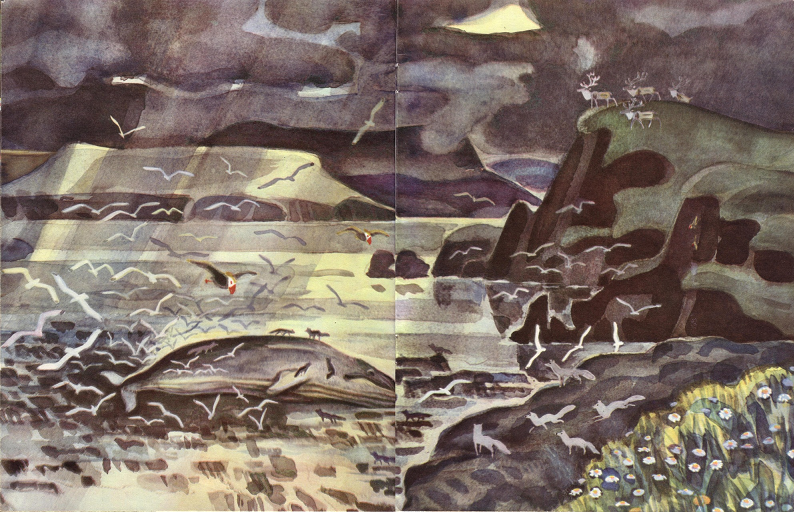На Командорах / On the Commander Islands – Foxes
 Quick and dirty translation, part 3. See also, part 1, Fur Seals and part 2, Sea Birds.
Quick and dirty translation, part 3. See also, part 1, Fur Seals and part 2, Sea Birds.
На Командорах [Na Komandorakh] On the Commander Islands. Author: Gennady Snegirev. Artist: M. Miturich. Izdatel’stvo “Malish”. Publisher “Little One”. For older preschoolers. A print run of 350,000 in 1975. Cost, 16 kopecks.
Full Russian book scanned here.
In the past, arctic foxes on the Commander Islands made their burrows underneath cabins, fought with the cats and didn’t let anyone sleep at night with their romping and growling under the floors. Then many were captured and put in a fur farm, where they live in open air cages. The foxes are fed fresh fish, whale meat, and dried fish strips called ‘yukola.’
The young foxes are completely tame, but keep an eye on them — they’re always looking out at the tundra: is it impossible to run away to freedom, to the wild foxes?
There it is, the fur farm; rows of cages and a biologist looking after the foxes. Do they have a good appetite? Have they fallen ill? Is their weight increasing? If they get exercise and good food, then the fox’s pelt will be thick and high quality.
They don’t forget the wild foxes either. The hunters make yukola in the summer and store it in little huts on the tundra. In winter, when there’s little food, they supplement the diet of the wild foxes. It happens that a dead whale washes up the shore. The wild foxes run to it from all over and begin to eat out burrows in the whale and live in it. They have meals and shelter together and don’t have to run around the tundra looking for food. But when they hunters find such a whale, they drive the foxes out and burn the whale — it is fatty and burns well. They do this to save the stupid foxes. The fat and oil from the whale gums up the fluffy fur of the foxes and they freeze to death when it gets cold.
Here’s a video in which arctic foxes on the Commander Islands steal fish, but are so adorable you can’t really be mad about it.
Fourth & final section to come: meteorologists and sled dogs.